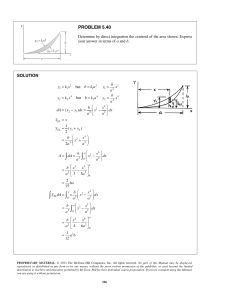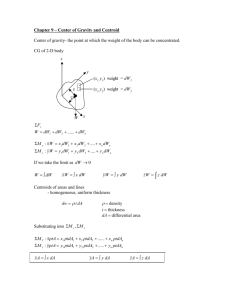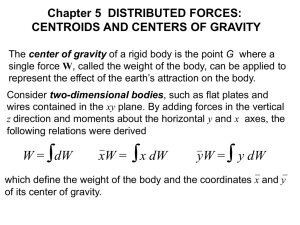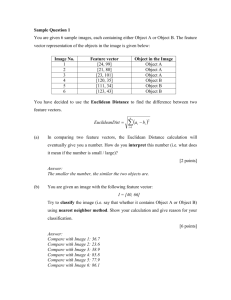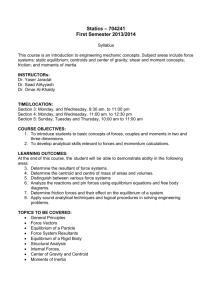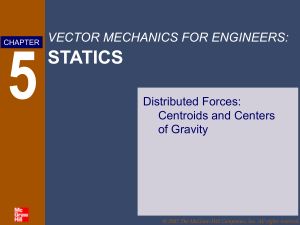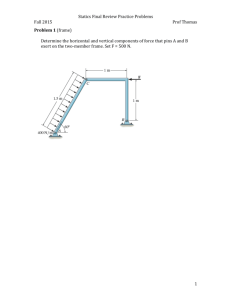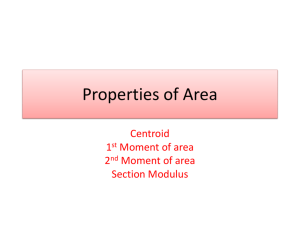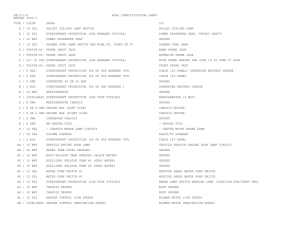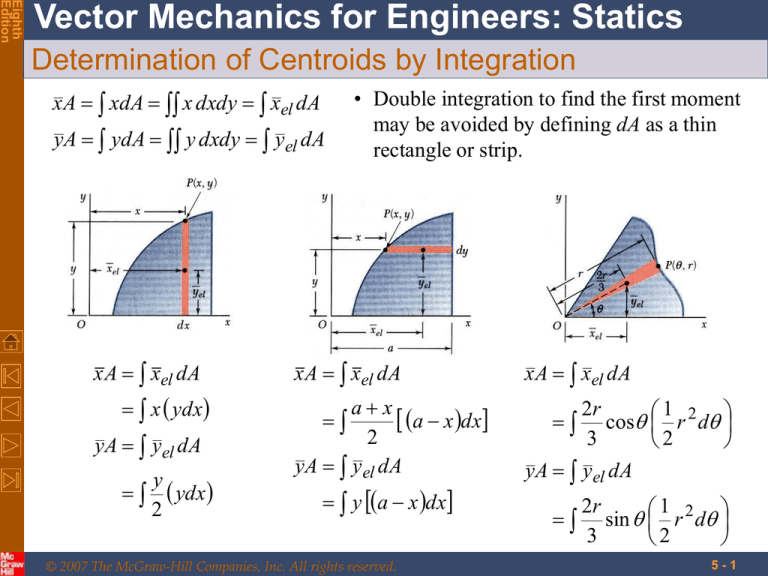
Eighth
Edition
Vector Mechanics for Engineers: Statics
Determination of Centroids by Integration
x A xdA x dxdy xel dA
yA ydA y dxdy yel dA
• Double integration to find the first moment
may be avoided by defining dA as a thin
rectangle or strip.
x A xel dA
x A xel dA
yA yel dA
ax
a x dx
2
yA yel dA
x ydx
y
ydx
2
y a x dx
© 2007 The McGraw-Hill Companies, Inc. All rights reserved.
x A xel dA
2r
1
cos r 2 d
3
2
yA yel dA
2r
1
sin r 2 d
3
2
5-1
Eighth
Edition
Vector Mechanics for Engineers: Statics
Sample Problem 7.2
SOLUTION:
• Determine the constant k.
• Evaluate the total area.
• Using either vertical or horizontal
strips, perform a single integration to
find the first moments.
Determine by direct integration the
location of the centroid of a parabolic
spandrel.
• Evaluate the centroid coordinates.
© 2007 The McGraw-Hill Companies, Inc. All rights reserved.
5-2
Eighth
Edition
Vector Mechanics for Engineers: Statics
Sample Problem 7.2
SOLUTION:
• Determine the constant k.
y k x2
b k a2 k
y
b
a2
x2
or
b
a2
x
a
b1 2
y1 2
• Evaluate the total area.
A dA
a
b x3
b 2
y dx 2 x dx 2
a 3 0
0a
ab
3
a
© 2007 The McGraw-Hill Companies, Inc. All rights reserved.
5-3
Eighth
Edition
Vector Mechanics for Engineers: Statics
Sample Problem 7.2
• Using vertical strips, perform a single integration
to find the first moments.
a
b
Q y xel dA xydx x 2 x 2 dx
0 a
a
b x4
a 2b
2
4
a 4 0
2
a
y
1 b
Qx yel dA ydx 2 x 2 dx
2
02a
a
b2 x5
ab 2
4
2a 5 0 10
© 2007 The McGraw-Hill Companies, Inc. All rights reserved.
5-4
Eighth
Edition
Vector Mechanics for Engineers: Statics
Sample Problem 7.2
• Or, using horizontal strips, perform a single
integration to find the first moments.
b 2
ax
a x2
a x dy
Q y xel dA
dy
2
2
0
1 b 2 a 2
a
2 0
b
2
a
b
y dy
4
a
Qx yel dA y a x dy y a 1 2 y1 2 dy
b
a 3 2
ab 2
ay 1 2 y dy
10
b
0
b
© 2007 The McGraw-Hill Companies, Inc. All rights reserved.
5-5
Eighth
Edition
Vector Mechanics for Engineers: Statics
Sample Problem 7.2
• Evaluate the centroid coordinates.
xA Q y
ab a 2b
x
3
4
3
x a
4
yA Q x
ab ab 2
y
3
10
© 2007 The McGraw-Hill Companies, Inc. All rights reserved.
y
3
b
10
5-6
Problem 7.6
y
20 mm
30 mm
Locate the centroid of the plane
area shown.
36 mm
24 mm
x
7
y
20 mm
Problem 7.6
30 mm
Solving Problems on Your Own
36 mm
Locate the centroid of the plane area
shown.
24 mm
Several points should be emphasized
when solving these types of problems.
x
1. Decide how to construct the given area from common shapes.
2. It is strongly recommended that you construct a table
containing areas or length and the respective coordinates of
the centroids.
3. When possible, use symmetry to help locate the centroid.
8
Problem 7.6 Solution
y
20 + 10
Decide how to construct the given
area from common shapes.
C1
C2
24 + 12
30
10
x
Dimensions in mm
9
Problem 7.6 Solution
y
20 + 10
Construct a table containing areas and
respective coordinates of the
centroids.
C1
C2
24 + 12
30
10
x
Dimensions in mm
A, mm2
1 20 x 60 =1200
2 (1/2) x 30 x 36 =540
S
1740
x, mm
10
30
y, mm
30
36
xA, mm3
12,000
16,200
28,200
yA, mm3
36,000
19,440
55,440
10
Problem 7.6 Solution
y
20 + 10
Then
XS A = S xA
X (1740) = 28,200
or X = 16.21 mm
and
YS A = S yA
Y (1740) = 55,440
C1
C2
24 + 12
30
10
x
or Y = 31.9 mm
Dimensions in mm
A, mm2
1 20 x 60 =1200
2 (1/2) x 30 x 36 =540
S
1740
x, mm
10
30
y, mm
30
36
xA, mm3
12,000
16,200
28,200
yA, mm3
36,000
19,440
55,440
11
Problem 7.7
a
24 kN
A
30 kN
0.3 m
B
wA
wB
1.8 m
The beam AB supports two
concentrated loads and
rests on soil which exerts a
linearly distributed upward
load as shown. Determine
(a) the distance a for which
wA = 20 kN/m, (b) the
corresponding value wB.
12
Problem 7.7
a
24 kN
A
30 kN
Solving Problems on Your Own
0.3 m
B
wA
wB
1.8 m
The beam AB supports two
concentrated loads and
rests on soil which exerts a
linearly distributed upward
load as shown. Determine
(a) the distance a for which
wA = 20 kN/m, (b) the
corresponding value wB.
1. Replace the distributed load by a single equivalent force.
The magnitude of this force is equal to the area under the
distributed load curve and its line of action passes through
the centroid of the area.
2. When possible, complex distributed loads should be
divided into common shape areas.
13
Problem 7.7 Solution
24 kN
a
30 kN
C
A
20 kN/m
Replace the distributed
load by a pair of
B equivalent forces.
wB
0.6 m
0.6 m
RI
We have
0.3 m
RII
1
RI = 2 (1.8 m)(20 kN/m) = 18 kN
1
RII = 2 (1.8 m)(wB kN/m) = 0.9 wB kN
14
Problem 7.7 Solution
a
24 kN
30 kN
0.3 m
C
A
B
wB
0.6 m
0.6 m
RI = 18 kN
RII = 0.9 wB kN
(a) + SMC = 0: (1.2 - a)m x 24 kN - 0.6 m x 18 kN
- 0.3m x 30 kN = 0
or a = 0.375 m
(b) + SF = 0: -24 kN + 18 kN + (0.9 w ) kN - 30 kN= 0
y
B
or wB = 40 kN/m
15
Problem 7.8
y
2 in
3 in
2 in
1 in
r = 1.25 in
x
z
For the machine element
shown, locate the z coordinate
of the center of gravity.
0.75 in
2 in
2 in
r = 1.25 in
16
Problem 7.8
y
2 in
2 in
1 in
3 in
Solving Problems on Your Own
r = 1.25 in
x
z
For the machine element
shown, locate the z coordinate
of the center of gravity.
Determine the center of
gravity of composite body.
2 in
r = 1.25 in
2 in
For a homogeneous body
the center of gravity coincides
with the centroid of its volume. For this case the center of gravity
can be determined by
0.75 in
XSV = SxV
YSV = SyV
ZSV = SzV
where X, Y, Z and x, y, z are the coordinates of the centroid of the
17
body and the components, respectively.
Problem 7.8 Solution
y
2 in
2 in
1 in
3 in
Determine the center of gravity
of composite body.
r = 1.25 in
First assume that the machine
element is homogeneous so
that its center of gravity will
coincide with the centroid of
the corresponding volume.
x
z
0.75 in
2 in
2 in
r = 1.25 in
y
V
Divide the body into
five common shapes.
III
II
IV
I
x
z
18
y
y
V
2 in
IV
I
III
3 in
2 in 1 in
r = 1.25 in
x
II
x
z
z
0.75 in
2 in
2 in
I
II
III
IV
V
S
V, in3
(4)(0.75)(7) = 21
(p/2)(2)2 (0.75) = 4.7124
-p(11.25)2 (0.75)= -3.6816
(1)(2)(4) = 8
-(p/2)(1.25)2 (1) = -2.4533
r = 1.25 in
z, in.
3.5
7+ [(4)(2)/(3p)] = 7.8488
7
2
2
27.576
Z S V = S z V : Z (27.576 in3 ) = 95.807 in4
z V, in4
73.5
36.987
-25.771
16
-4.9088
95.807
Z = 3.47 in 19


